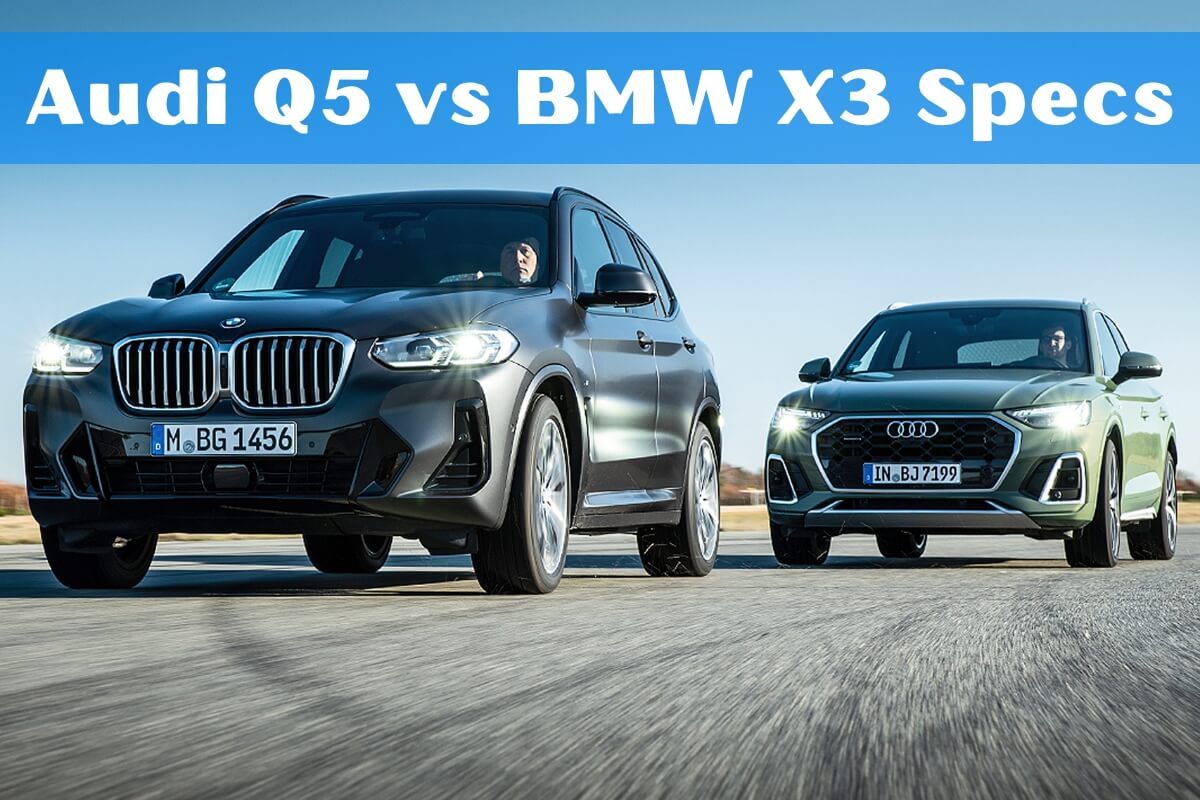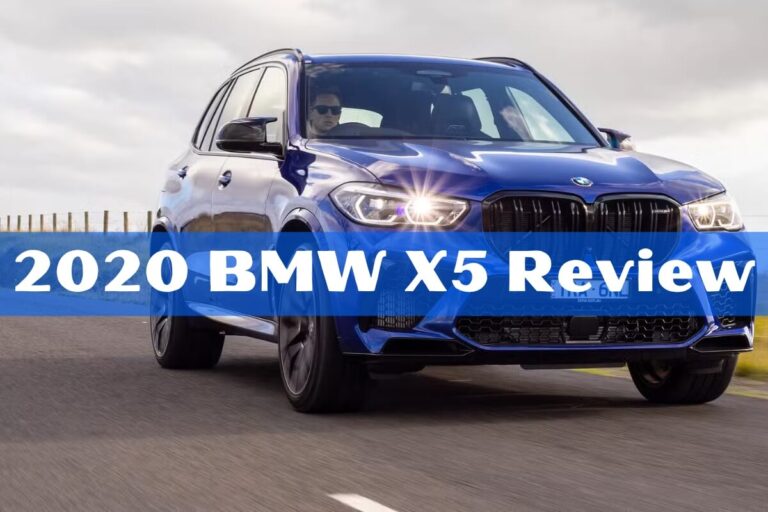Audi Q5 vs BMW X3 Specs: Luxury SUV Showdown

Are you trying to decide between the Audi Q5 and BMW X3 for your next luxury SUV purchase? Both vehicles offer impressive performance, features, and comfort, making it a tough choice. This detailed comparison will dive into the key specs of the Audi Q5 and BMW X3 to help you determine which one better suits your needs.
The Audi Q5 and BMW X3 are both premium compact SUVs. They compete in a crowded market segment, going up against rivals like the Mercedes-Benz GLC, Lexus NX, and Volvo XC60. While they share some similarities, there are notable differences in areas such as:
- Engine options and performance
- Dimensions and interior space
- Standard and available features
- Pricing and trim levels
This comprehensive guide will compare the Audi Q5 vs BMW X3 across all these crucial aspects. We’ll examine the facts, figures, and real-world performance to give you a clear picture of how these two luxury SUVs stack up.
Performance: Potent Engines and Capable Handling
When it comes to performance, both the Audi Q5 and BMW X3 deliver a punchy and engaging driving experience. However, there are some key distinctions in their engine lineups and overall capabilities.
Audi Q5 Engine Options
The 2024 Audi Q5 offers three different engine choices:
- 2.0L Turbocharged I-4 (201 hp): This is the base engine, delivering 201 horsepower and 236 lb-ft of torque. It’s paired with a seven-speed automatic transmission and Quattro all-wheel drive.
- 2.0L Turbocharged I-4 (261 hp): A step up from the base, this turbo-four pumps out 261 hp and 273 lb-ft of torque. It can propel the Q5 from 0-60 mph in just 5.5 seconds.
- 2.0L Turbocharged I-4 Plug-In Hybrid (362 hp): The range-topping powertrain combines a turbo engine with an electric motor for a stout 362 hp and 369 lb-ft of torque. This PHEV setup enables electric-only driving and impressive acceleration (0-60 mph in 5 seconds).
BMW X3 Engine Lineup
The 2024 BMW X3 takes a slightly different approach with its engine options:
- 2.0L Turbocharged I-4 (248 hp): Standard on base trims, this turbo-four makes 248 hp and 258 lb-ft of torque. It hits 60 mph in 6.2 seconds with all-wheel drive.
- 3.0L Turbocharged I-6 (382 hp): Available on the M40i trim, this inline-six cranks out 382 hp and 369 lb-ft of torque for thrilling acceleration.
- 3.0L Turbocharged I-6 (473 hp): Exclusive to the range-topping X3 M, this high-output six-cylinder unleashes 473 hp and 457 lb-ft of torque. The 0-60 mph sprint takes just 3.9 seconds.
While the Audi Q5 prioritizes efficiency with turbocharged four-cylinders and a plug-in hybrid option, the BMW X3 leans more toward outright performance. The X3 M’s 473-hp turbo-six is significantly more powerful than anything in the Q5 lineup.
However, the Q5’s PHEV powertrain provides a nice balance of power and eco-friendliness. And for most daily driving situations, the Q5’s base and mid-tier turbo-fours offer plenty of get-up-and-go.
Both SUVs feature precise steering and composed handling that befits their luxury pedigrees. The Audi Q5’s standard Quattro AWD may give it an edge in adverse weather conditions. But the BMW X3 feels slightly more agile and connected when pushing the limits on twisty roads.
Dimensions: Living Space and Cargo Room
Let’s look at how the interior dimensions and cargo space compare between these two compact luxury SUVs:
Audi Q5 Interior Dimensions:
- Headroom (front/rear): 39.6 in / 39.3 in
- Legroom (front/rear): 40.9 in / 38.0 in
- Shoulder Room (front/rear): 57.7 in / 56.5 in
BMW X3 Interior Dimensions:
- Headroom (front/rear): 41.1 in / 41.1 in
- Legroom (front/rear): 40.3 in / 36.4 in
- Shoulder Room (front/rear): 57.6 in / 56.0 in
The BMW X3 has a slight advantage in front headroom and rear headroom. However, the Audi Q5 offers more rear legroom, which could be beneficial for taller passengers.
Cargo Space
- Audi Q5: 25.9 cu-ft (behind rear seats) / 54.1 cu-ft (rear seats folded)
- BMW X3: 28.7 cu-ft (behind rear seats) / 62.7 cu-ft (rear seats folded)
When it comes to hauling cargo, the BMW X3 simply has more room – both behind the rear seats and with them folded down. Its higher roofline likely contributes to the extra cargo volume.
So if interior passenger space is the priority, the Q5 may be preferable thanks to its generous rear legroom. But if you frequently carry larger items or luggage, the X3’s bigger cargo hold could be the deciding factor.
Feature Comparison: Tech, Luxury & Safety
Premium features, the latest tech, and cutting-edge safety gear are essential in the luxury SUV segment. Let’s examine how the Audi Q5 and BMW X3 stack up in these key areas.
Infotainment and Tech Features
Both SUVs come standard with:
- 10+ inch touchscreen displays
- Wireless Apple CarPlay and Android Auto
- Built-in navigation
- Voice command functionality
- Available premium audio upgrades
The Audi Q5 includes some unique available tech like:
- Temperature-controlled cupholders
- Customizable ambient interior lighting
While the BMW X3 counters with options like:
- Fully digital instrument cluster
- Gesture control for infotainment system
In terms of infotainment, it’s a toss-up. Both systems are modern, user-friendly, and packed with the latest connectivity features.
Interior Luxury and Comfort
Here’s where the Q5 may have a slight edge over the X3:
- Standard leather upholstery (vinyl on base X3)
- Available heated rear seats
- More available customization options
However, the X3’s cabin is still impeccably crafted with high-end materials. It just starts a little more basic before adding luxury options.
Active Safety Technology
These days, advanced driver aids are a must-have – even in the luxury space. Fortunately, both the Audi and BMW come through:
Standard safety tech on both:
- Forward collision warning
- Automatic emergency braking
- Blind-spot monitoring
- Rear cross-traffic alert
- Lane departure warning
The Audi Q5 goes a step further by including lane-keeping assist and automatic high beams as standard equipment.
Available safety upgrades include:
- Adaptive cruise control
- Surround-view camera systems
- Semi-autonomous parking assist
While the BMW X3’s standard safety suite is comprehensive, the Q5’s extra standard driver aids could provide a little more peace of mind.
Pricing and Value
Pricing can be the deciding factor when shopping luxury vehicles like the Audi Q5 and BMW X3. Here’s a quick breakdown of starting MSRPs for 2024:
2024 Audi Q5
- Premium (base): $45,300
- Premium Plus: $50,100
- Prestige: $55,600
2024 BMW X3
- sDrive30i (base): $46,900
- xDrive30i: $48,900
- M40i: $61,900
- X3 M: $75,500
At the lower end of the trim lineup, the Audi Q5 and BMW X3 are priced closely – with the Q5 holding a slight advantage.
However, as you move up the trim levels, the price gap widens considerably.
The range-topping BMW X3 M commands a steep $75,500 starting price. That’s over $20,000 more than the top-spec Audi Q5 Prestige, which starts at $55,600.
Of course, the X3 M justifies its premium with its high-output 473-hp twin-turbo inline-six. But even the mid-tier X3 M40i carries a $61,900 base MSRP – higher than any Q5 trim.
It’s worth noting that pricing can fluctuate based on options, packages, and dealer markups/discounts. But in general, the Audi Q5 tends to offer more bang for your buck across most trim levels.
The Verdict: Which Luxury SUV is Right for You?
After thoroughly comparing the Audi Q5 and BMW X3 spec-for-spec, it’s clear that both are exceptional luxury SUVs with their own unique strengths.
The 2024 Audi Q5 stands out with:
- More affordable pricing, especially on upper trims
- Slightly roomier rear legroom
- Impressive standard tech and luxury features
- Plug-in hybrid powertrain option for electrified performance
Reasons to choose the 2024 BMW X3 include:
- Powerful inline-six engine upgrades (M40i and M models)
- Slightly more cargo space behind the rear seats
- Sportier, more agile handling dynamics
- Iconic BMW driving experience and brand cachet
For many luxury buyers, the decision may come down to priorities. If you value performance above all else and have a bigger budget, the BMW X3’s higher-output engines could be the deciding factor.
However, the Audi Q5 makes a compelling case as the smarter choice for value-conscious buyers. Its potent yet efficient powertrains, lengthy list of standard equipment, and spacious interior give it an edge over the comparably-priced X3 trims.
Ultimately, there is no objectively “better” SUV here. The Audi Q5 and BMW X3 both excel at blending luxury and performance into an immensely satisfying compact SUV package. By carefully weighing your needs and wants, you can’t go wrong with either German luxury powerhouse.
Final Thoughts
Choosing between two premium vehicles like the Audi Q5 and BMW X3 is no easy task. Both offer exceptional quality, performance capabilities, and all the latest bells and whistles you’d expect from a modern luxury SUV.
While the BMW X3 aims to please driving enthusiasts with its powerful (and thirsty) inline-six engine options, the Audi Q5 could be the smarter overall pick. Its blend of punchy turbocharged power, outstanding efficiency, roomy cabin, and tremendous value across the trim lineup is downright impressive.
Of course, your personal needs and priorities should determine which model is the best fit. If straight-line performance and handling prowess reign supreme, the BMW’s top trims could deliver the level of thrills you crave. But for most luxury SUV buyers, the well-rounded and attainable luxury of the Audi Q5 will likely hit the sweet spot.
No matter which German SUV you choose, you’re in for an upscale driving experience packed with the latest tech and amenities. Just be sure to test drive both the Audi Q5 and BMW X3 to see which one truly speaks to you before signing on the dotted line.






